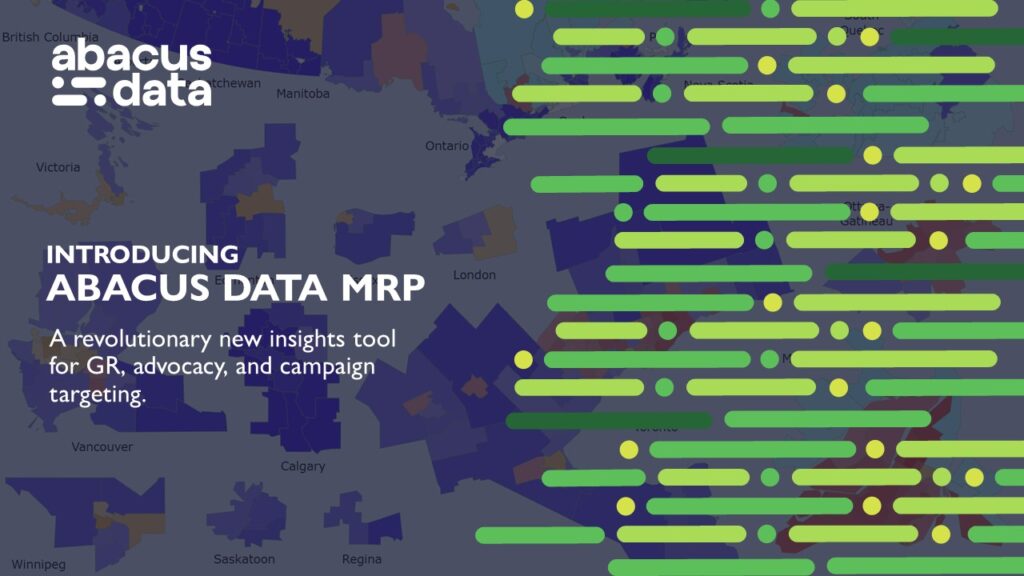For Gen Z this is still the cost-of-living election, but will they vote?
The inauguration of President Trump, tariff announcements and other commentary, and a new Prime Minister, have changed the landscape of Canadian politics, including our top issues. But for young Canadians, this is still a cost-of-living election. What remains to be seen is whether they will be motivated to turn out and vote.
The results in this release are taken from two surveys conducted since the campaign began. A survey of n=1,487 18+ adults in Canada from March 17th to 20th and a survey of n=1,800 18+ adults in Canada March 24th to 26th.
Top Issues
There are two clear top issues dominating this election cycle. Reducing the cost of living, which has been a top issue for some time, is a top two issue for 47% of Canadians. Dealing with President Trump is now the number two overall issue for Canadians at 35%. All other issues trail behind these two: growing the economy at 19%, making housing more affordable at 19%, improving the healthcare system at 16%, and making Canada a better place to live at 15%.

Over the first week of the campaign these top issues have only become more important. Cost of living rising two points (still no statistically significant changes here) and dealing with President Trump and the impact of his decisions seeing a similar bump.
What is significant however is how this has pulled attention away from other issues. The collective increase of 4 points among these top two issues have meant things like healthcare have fallen down the list since the start of the campaign.

But this list varies considerably by generation. The top issue for Boomers is dealing with President Trump (49%), ahead of everything else, including cost of living by a significant margin.
The landscape looks considerably different for Gen Z, who place cost of living as their top issue (46%), followed by housing affordability (33%). Dealing with President Trump is a distant third at 23%. There is a 15-point gap between how much importance Gen Z places on President Trump vs. everyone else.
Gen Z also places more emphasis on the environment in their vote compared to others.

Vote Intention
Despite these differences vote intention between generations is looking similarly tied.
The Liberals lead among Gen Z and Boomers, and are in a much tighter race than they were in December among millennials and Gen X. Among Gen Z, the pull of votes towards the Liberals is clearly coming from the NDP vote. They have dropped 14 points among this generation since December.
But among older voters, especially Boomers, the pull towards the Liberals is from both sides.

Leader Impressions
Younger Canadians tend to have softer impressions of Pierre Poilievre. Since the campaign began, impressions among Gen Z and Millennials are net positive, by a small margin. But Boomers feel particularly negative about Mr. Poilievre with a -19 net impression.
Boomers’ impression of Mark Carney is the opposite. A +19 impression of the Prime Minister, and the generation who has the most positive impressions of the leader.
Carney is also highly favoured among Gen Z, 38% have a positive impression and 22% a negative impression (the lowest negatives among all generations).

Turnout
One of the biggest questions in this election remains voter turnout. Voter turnout has consistently been higher among older Canadians and the data is showing this trend is likely to continue. 84% of Boomers say they are certain to vote this election, compared to 42% of Gen Z.
If these turnout numbers hold, the election is likely to be decided by generations other than Gen Z- which means it is shaping up to be an election about Canada-US relations.

The Upshot
Vote intention is looking similar among generations so far, but this election is about a very different list of issues for Gen Z compared to everyone else. Gen Z remains in a cost-of-living crisis as well as a reality where many big milestones, like purchasing a house, remain out of reach. They have remained more consistently in the pre-Trump reality, of this being a cost-of-living election.
But other, older generations have moved on and are placing increasing focus on Canada-US relations. Right now, these older generations are also far more motivated to vote, paying more attention to what is happening and as a result, more successfully shaping the election narrative and likely the election outcome, too – it’s not just an election issue, it’s a national priority.
Methodology
The results in this release are taken from two surveys conducted since the campaign began. A survey of n=1,487 18+ adults in Canada from March 17th to 20th and a survey of n=1,800 18+ adults in Canada March 24th to 26th.
The first survey was conducted with 1,487 Canadian adults from March 17 to 20, 2025. A random sample of panelists were invited to complete the survey from a set of partner panels based on the Lucid exchange platform. These partners are typically double opt-in survey panels, blended to manage out potential skews in the data from a single source.
The margin of error for a comparable probability-based random sample of the same size is +/- 2.54%, 19 times out of 20.
The data were weighted according to census data to ensure that the sample matched Canada’s population according to age, gender, educational attainment, and region.
The second survey was conducted with 1,800 Canadian adults from March 24 to 26, 2025. A random sample of panelists were invited to complete the survey from a set of partner panels based on the Lucid exchange platform. These partners are typically double opt-in survey panels, blended to manage out potential skews in the data from a single source.
The margin of error for a comparable probability-based random sample of the same size is +/- 2.31%, 19 times out of 20.
The data were weighted according to census data to ensure that the sample matched Canada’s population according to age, gender, educational attainment, and region.
Abacus Data follows the CRIC Public Opinion Research Standards and Disclosure Requirements that can be found here: https://canadianresearchinsightscouncil.ca/standards/
About Abacus Data
We are the only research and strategy firm that helps organizations respond to the disruptive risks and opportunities in a world where demographics and technology are changing more quickly than ever.
We are an innovative, fast-growing public opinion and marketing research consultancy. We use the latest technology, sound science, and deep experience to generate top-flight research-based advice to our clients. We offer global research capacity with a strong focus on customer service, attention to detail, and exceptional value.
We were one of the most accurate pollsters conducting research during the 2021 Canadian election following up on our outstanding record in 2019.
Contact us with any questions
Find out more about how we can help your organization by downloading our corporate profile and service offering.













































































